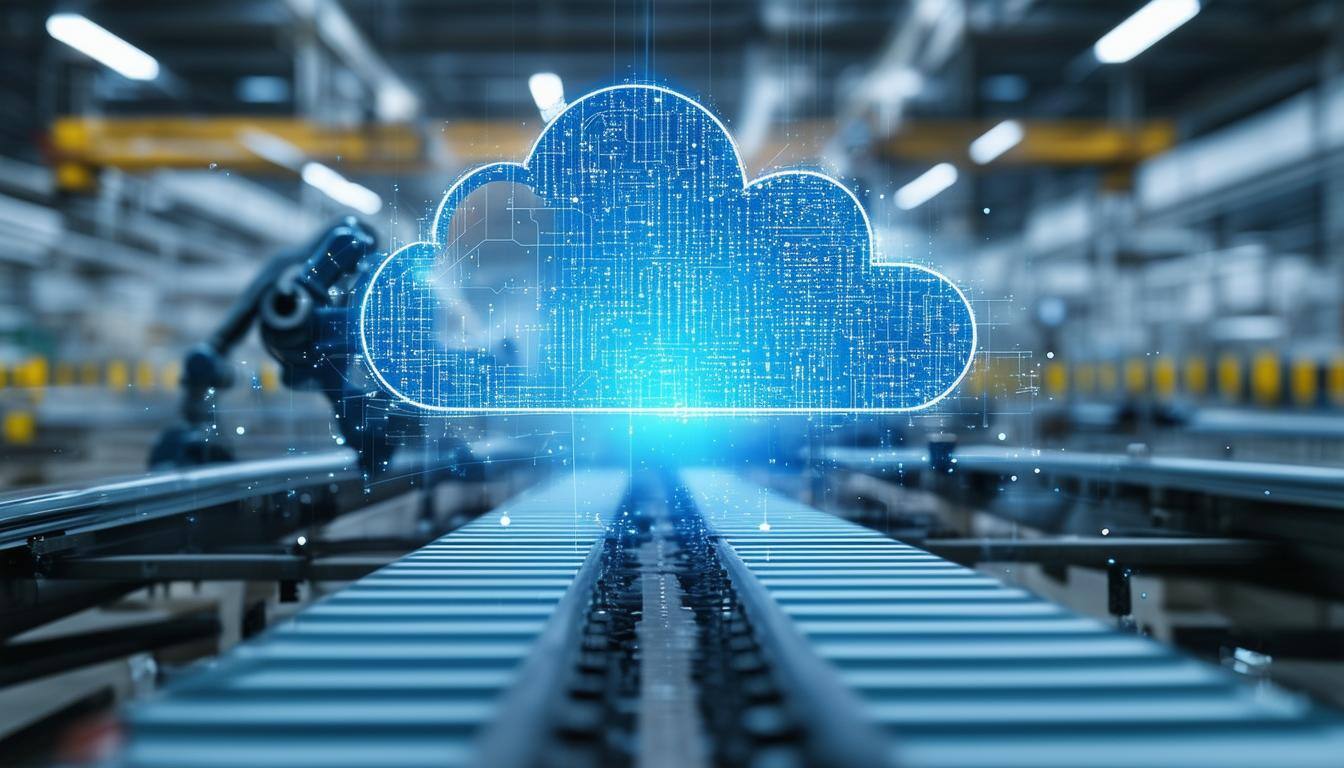5 min read
The Future of Energy Storage: Technologies Set to Power 2026 and Beyond
The global energy transition is accelerating. Solar and wind energy are no longer niche players but foundational components of the global energy...
8 min read
 Blake Snider
:
May 21, 2025 9:00:15 AM
Blake Snider
:
May 21, 2025 9:00:15 AM
Traditional power grids aren’t designed to meet the demands of the future of smart grid technology. As renewables scale and energy consumption shifts, driven by electric vehicles, AI data centers, and electrified industry, aging infrastructure is falling behind. Blackouts, rising costs, and energy waste signal a system under growing pressure.
Electricity use is forecast to grow nearly 4% each year through 2027, according to the IEA, marking the fastest pace in recent years. This surge demands smarter solutions. Smart grids, when paired with IFS Cloud for Energy and Utilities, become truly scalable. IFS feeds real-time SCADA and IoT data straight into Asset Performance Management (APM) and Field Service Management (FSM), turning sensor insights into automated work orders and optimized crew schedules. They adapt to fluctuating supply, balance energy loads, and enable efficient integration of renewables. For technology leaders, investing in these systems is about building a grid that can keep up with the energy economy of the future.
AI and machine learning are fundamental components of the smart grid, acting as the "brain" behind energy management systems. These technologies process vast amounts of data generated by grid sensors and devices, enabling real-time analysis of power usage, network conditions, and predictive insights. With AI, utilities can detect faults, predict maintenance needs, and even prevent outages before they happen.
Machine learning algorithms constantly improve over time, refining energy distribution and optimizing grid operations. This enhances forecasting accuracy and supports better integration of renewable energy sources, which are often unpredictable. In turn, this leads to more efficient energy management and greater grid stability, especially when forecasts are pushed into IFS Cloud APM, where maintenance plans, spare-parts inventory, and dispatch routes adjust automatically.
The IoT, with its network of interconnected devices, plays a crucial role in enabling smart grids to function smoothly. Sensors embedded in various parts of the grid gather real-time data about energy consumption, grid health, and environmental conditions. This data allows for precise energy management, helping to prevent overloads, detect faults, and balance the energy load across different regions.
Furthermore, IoT-powered smart meters provide both consumers and utilities with insights into energy usage, enabling more informed decisions about energy consumption patterns. These technologies allow for more dynamic and efficient responses to fluctuations in demand and supply, improving grid reliability and minimizing energy waste.
At the heart of smart grid technology is the smart meter, a device that allows for real-time monitoring of energy consumption. With smart meters, consumers and utility companies gain a detailed, immediate view of energy usage, enabling dynamic pricing models based on actual consumption.
Advanced Metering Infrastructure (AMI) complements this by supporting the collection, transmission, and analysis of this data. Utilities can optimize energy supply by predicting peak demand times and adjusting the flow of energy accordingly. Smart meters also facilitate better demand response and support the integration of renewable energy, reducing reliance on fossil fuels.
Energy storage solutions are essential to managing the intermittency of renewable energy sources. While renewable power generation is crucial for a sustainable future, its reliance on weather conditions means that energy availability can vary. Energy storage systems, such as advanced batteries and pumped hydro storage, capture excess energy during periods of high generation and store it for use when demand exceeds supply. This ensures a stable energy supply and reduces the need for backup fossil fuel power generation. Because storage assets are capital-intensive and warranty-sensitive, utilities rely on IFS Cloud Projects & Asset Lifecycle to track capex, warranties, and performance KPIs in one place, accelerating ROI while safeguarding reliability.
Power electronics are vital for integrating renewable energy sources and storage systems into the grid. These devices help convert and regulate the flow of electricity, ensuring it is in the correct form for use by homes, businesses, and industrial facilities. Power electronics enable bidirectional energy flow, allowing for the transfer of excess energy back to the grid. For example, electric vehicles (EVs) can store energy when demand is low and return it to the grid when demand spikes. This flexibility makes power electronics a critical piece of modern energy infrastructure, allowing for better energy management, reduced transmission losses, and more effective integration of renewable energy sources.
While still an emerging application in the energy sector, blockchain technology holds considerable promise for enhancing security and transparency in energy transactions. Its decentralized and immutable ledger system can create a secure platform for tracking energy generation, distribution, and consumption. This is particularly relevant for supporting peer-to-peer energy trading, where consumers can directly buy and sell energy from one another.
Blockchain can also streamline the certification of renewable energy and improve the traceability of energy resources, contributing to a more transparent and efficient energy market. Its application could foster greater trust and participation in local energy initiatives and microgrids. Layering IFS Cloud’s multi-site ledger on top of these microgrids consolidates financial and operational KPIs, while pilot blockchain platforms handle peer-to-peer settlements.
One of the most significant benefits of smart grids is their capacity to improve the reliability and resilience of the power supply. Smart grids are designed with self-healing capabilities, meaning they can automatically detect, isolate, and often reroute power around faults, minimizing the scope and duration of outages.
Proactive issue detection, driven by AI and an extensive sensor network, allows utilities to address potential problems before they escalate into major disruptions. This results in a more stable power supply, which is crucial for modern economies and critical infrastructure. The ability to quickly recover from disturbances, whether from equipment failure or extreme weather, makes the energy network more robust.
Smart grids optimize the flow of electricity, thereby minimizing energy losses that commonly occur during transmission and distribution in traditional power grid systems. This efficient energy management translates directly into cost savings. Predictive maintenance, enabled by constant monitoring and AI analytics, helps reduce the expenses associated with unexpected equipment failures and emergency repairs.
Utilities can schedule maintenance more effectively, extending the lifespan of assets and lowering operational expenditures. Furthermore, consumers can benefit from lower energy costs through better management of their energy usage, facilitated by smart meter data and dynamic pricing options. The effective data management required for these optimizations is significantly enhanced by robust ERP systems.
With smart grids, customers have greater control over their energy usage and consumption patterns. Through smart meters and energy management platforms, consumers can monitor their energy consumption in real time, allowing them to make informed decisions about when and how to use energy. This increased visibility fosters greater engagement with the grid, leading to a deeper understanding of how energy works and how it can be optimized.
Additionally, smart grids offer dynamic pricing, enabling consumers to benefit from lower rates during off-peak hours. These benefits lead to higher customer satisfaction and more proactive participation in energy management.
As critical infrastructure, the energy grid is a target for physical and cyber threats. Smart grid technologies incorporate advanced security measures to protect the grid infrastructure from cyberattacks, unauthorized access, and other potential threats. These measures include sophisticated encryption, multi-factor authentication, intrusion detection systems, and continuous monitoring of network traffic.
While the interconnected nature of smart grids introduces new security considerations, the digital technologies employed also provide more tools to identify and neutralize threats swiftly. Protecting the integrity and availability of the energy supply is paramount, and robust security protocols are a fundamental aspect of smart grid design and operation.
Leveraging AI and machine learning algorithms, smart grids can significantly optimize the power output from various energy generation sources, particularly intermittent renewable energy sources. AI can analyze weather patterns, historical generation data, and real-time grid conditions to predict the output of solar and wind farms with greater accuracy. This allows for better scheduling of other generation sources and energy storage systems to ensure a balanced and stable energy supply.
The adoption of smart grid technologies requires significant upfront investment in infrastructure, sensors, meters, and control systems. These costs can be a barrier for some utilities, especially in regions with limited budgets. However, when utilities model projects in IFS Cloud Enterprise Project Management, total-cost simulations reveal payback periods shrink as O&M savings, demand-response revenue, and regulatory incentives are captured. Phased rollouts, government incentives, and public-private partnerships can help mitigate these costs and accelerate the transition to smarter grids.
Integrating diverse protocols (DERMS, SCADA, GIS, AMI) can stall deployment. IFS Cloud’s open REST and OData APIs broker data across these systems, while its built-in integration service bus cuts custom coding. Industry-wide standards still matter, but a pre-integrated ERP layer accelerates time-to-value and de-risks future upgrades. To overcome this, the development of industry-wide standards and open communication between vendors and utilities is essential. Collaboration and innovation will drive interoperability and make it easier for utilities to integrate new technologies into the grid.
The increase in data collection and connectivity in smart grids raises concerns about cybersecurity and privacy. Smart meters and sensors generate vast amounts of data about energy usage, which can be vulnerable to cyberattacks if not properly secured. Robust cybersecurity frameworks, including encryption and access control, are essential to protect sensitive information and prevent data breaches. Utilities must prioritize cybersecurity measures to ensure the integrity of smart grid systems.
Inconsistent regulations and fragmented policies across regions can hinder the widespread adoption of smart grids. Policymakers must work together to create standardized regulations that promote innovation while protecting consumers and the environment. Collaboration between governments, utilities, and industry stakeholders is necessary to develop clear, supportive policies that accelerate the adoption of smart grid technologies.
Many consumers are unaware of the benefits of smart grids or are hesitant to change their energy consumption habits. To overcome this barrier, utilities must invest in education and outreach programs that explain how smart grids work and the advantages they offer. Incentives, such as rebates for smart meter installations or dynamic pricing models, can encourage consumers to participate in smart grid programs and adopt energy-efficient behaviors.
Emerging technologies like Silicon Carbide (SiC) and Gallium Nitride (GaN) are revolutionizing power electronics, making them more efficient, compact, and capable of handling higher power densities. These advancements will enable more robust and reliable energy systems, facilitating the integration of renewable energy sources and improving grid performance. Power electronics will continue to evolve, contributing to smarter, more efficient grids.
The role of artificial intelligence and the Internet of Things will expand, leading to increasingly autonomous grid operations. Smart grids are moving towards systems that can self-heal more effectively, predict and preemptively address a wider range of potential issues, and continuously refine operations with minimal human intervention. AI algorithms will become more sophisticated in managing complex scenarios, such as fluctuating renewable energy generation and dynamic changes in energy demand. This heightened autonomy will improve grid reliability, reduce operational costs, and accelerate response times to disturbances, further minimizing outages.
Continued development in energy storage technologies, such as advanced batteries and supercapacitors, will enable smarter grids to more effectively balance supply and demand. These innovations will make it easier to store excess renewable energy and deploy it when needed, ensuring a more reliable and sustainable power supply.
The trend towards decentralized energy systems is gaining momentum. Microgrids—localized grids that can operate autonomously or in connection with the main grid—are becoming important building blocks within the larger smart grid architecture. They offer enhanced local resilience, particularly for critical facilities like hospitals or in remote communities. Microgrids facilitate the easier integration of local renewable energy generation and energy storage systems. The integration of blockchain technology with microgrids could also enable secure and efficient local energy trading and management, empowering communities and fostering a more distributed energy landscape.
The future of smart grids will see increased integration with smart cities and digital twins. These technologies will create a more interconnected and efficient energy ecosystem, where data from smart grids can be used to optimize urban planning and infrastructure. Digital twins, virtual replicas of physical systems, will allow for real-time simulation and optimization of energy networks, improving overall grid performance and sustainability.
Future smart grids will likely feature more sophisticated models for consumer participation. Peer-to-peer (P2P) energy trading platforms will become more common, allowing consumers to directly buy and sell energy generated from their own renewable energy systems. Advanced demand-side management programs will offer more granular control and incentives for consumers to adjust their energy usage in response to grid conditions or price signals. This includes managing smart appliances and electric vehicle charging to align with periods of high renewable energy generation or low overall energy demand, turning homes and businesses into active participants in grid management.
As smart grids become more complex and interconnected, the need for even stronger cybersecurity protocols will intensify. Future efforts will focus on developing more adaptive and proactive security measures, including AI-powered threat detection and response systems. There will be a greater emphasis on "security by design," where cybersecurity considerations are embedded into every layer of the smart grid architecture from the outset. International collaboration on cybersecurity standards and threat intelligence sharing will also be crucial for defending critical smart grid infrastructure against evolving global cyber threats, ensuring the modern energy system remains secure and resilient.
Building the next generation of energy infrastructure requires integrated, intelligent energy solutions that can scale with shifting demand, support distributed generation, and optimize performance across the grid.
The transition to smarter grids is already underway. Technologies like AI-driven analytics, modular energy storage, and adaptive power electronics are changing how energy is managed, consumed, and traded. However, turning innovation into impact requires deep system knowledge and implementation expertise.
That’s where Astra Canyon comes in. We help organizations cut through complexity with IFS ERP solutions designed specifically for the energy and utility sectors. From aligning operations to scaling smart grid technologies, our consultants work with you to build energy systems that are efficient, resilient, and ready for what’s next.
Let’s design a more connected, cost-effective, and sustainable future together. Reach out today to explore how Astra Canyon can support your smart grid strategy with proven technology and hands-on expertise.

5 min read
The global energy transition is accelerating. Solar and wind energy are no longer niche players but foundational components of the global energy...

Forward-looking executives are constantly evaluating ways to stay competitive, reduce inefficiencies, and maintain regulatory compliance. Upgrading...

Energy sector leaders and sustainability managers face increasing pressure to adopt cleaner, more resilient power solutions. With 2026 rapidly...